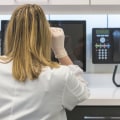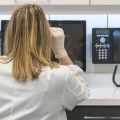Digital electronic dosimeters are used to measure, monitor, and record the personal radiation doses received by individuals, as well as to monitor environmental dose rate levels. These devices usually come with an alarm to alert when preset dose levels or dose rates are exceeded. A dosimeter is a device that measures the absorption of external ionizing radiation. It is used by the person being monitored when used as a personal dosimeter and serves as a record of the radiation dose received.
Modern electronic personal dosimeters can provide a continuous reading of the cumulative dose and the current dose rate, and can alert the user with an audible alarm when a specified dose rate or cumulative dose is exceeded. Other dosimeters, such as thermoluminescent or film types, require post-use processing to reveal the cumulative dose received, and cannot give a current dose indication while in use. Different work environments require measuring and detecting radiation levels. Dosimeters were developed to measure an absorbed dose of ionizing radiation. Passive dosimeters are also known as occupational dosimetry because they are used for legal dose registration and regulatory compliance. Electronic personal dosimeters use a metal oxide semiconductor field-effect transistor (MOSFET or MOS transistor) that triggers an alarm when radiation levels exceed regulatory compliance.
Passive dosimeters record the amount of radiation a person absorbs over a given period of time, such as a week or a year, so that they can be collected and analyzed later. Mirion Dosimetry Services has innovated a third type of dosimeter, the on-demand dosimeter that lies between electronic and passive. Such devices are known as legal dosimeters if they have been approved for use in personnel dose recording for regulatory purposes. Geiger Müeller (GM) meters are extremely sensitive dosimeters that use a gas chamber to detect radiation. The dosimeter plays an important role within the international radiation protection system developed by the International Commission on Radiological Protection and the International Commission on Radiation Units and Measures.
Radiographers, nuclear power plant workers, doctors using radiation therapy, hazardous materials workers, and others in situations involving the handling of radionuclides must often use dosimeters in order to record occupational exposure. Radiation workers often use an electronic personal dosimeter (EPD), defined as those working in planned exposure situations. The personal ionizing radiation dosimeter is of fundamental importance in the disciplines of radiation dosimetry and radiation health physics and is primarily used to estimate the radiation dose deposited on a person wearing the device. They have the speed and self-processing capability of an electronic dosimeter, adapted to the purposes of a passive dosimeter. The dosimeter is located on or adjacent to the items that are irradiated during the process as a validation of the received dose levels.


